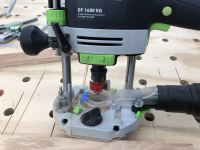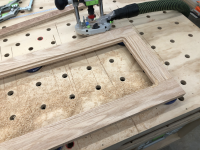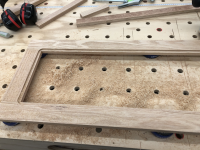Rick Herrick
Member
- Joined
- Feb 7, 2020
- Messages
- 793
First use of my 1400. I have 6 doors I need to route a recess in for the center panels. DC isn't stellar at all. One of Eric's videos, on YT/Poplar Shop, showed how you could remove the door on the shroud to allow a larger bit. I tried a bit of tape to help close it up. Initially I had it on bench cookies so it was up in the air, possibly contributing to my issue. I then clamped directly to bench, and still not so good. My CT26 is on high. I put a pile of dust on the table and set router on it and it sucked it all up just fine. So I feel my DC and hose are doing good. So not sure what else I need to do.
Another issue (skills issue). I read that when doing this, if going around the outside of the piece, move the router counter-clockwise. If on the inside, go clockwise. When doing this inside track, going clockwise seems to want to chew up the material. I get big pieces of wood instead of dust. If I go CC, it seems better but I have to hold on to the router as it wants to move faster than I would like.
Another issue (skills issue). I read that when doing this, if going around the outside of the piece, move the router counter-clockwise. If on the inside, go clockwise. When doing this inside track, going clockwise seems to want to chew up the material. I get big pieces of wood instead of dust. If I go CC, it seems better but I have to hold on to the router as it wants to move faster than I would like.



